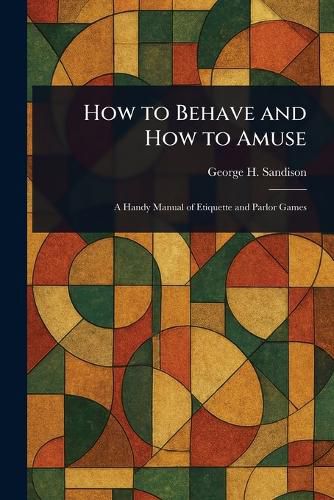Readings Newsletter
Become a Readings Member to make your shopping experience even easier.
Sign in or sign up for free!
You’re not far away from qualifying for FREE standard shipping within Australia
You’ve qualified for FREE standard shipping within Australia
The cart is loading…






This title is printed to order. This book may have been self-published. If so, we cannot guarantee the quality of the content. In the main most books will have gone through the editing process however some may not. We therefore suggest that you be aware of this before ordering this book. If in doubt check either the author or publisher’s details as we are unable to accept any returns unless they are faulty. Please contact us if you have any questions.
"How to Behave and How to Amuse: A Handy Manual of Etiquette and Parlor Games" offers a fascinating glimpse into the social customs and amusements of a bygone era. Authored by G.H. Sandison, this meticulously prepared reprint provides instruction and guidance on proper social behavior alongside a delightful collection of parlor games.
Explore the essential elements of etiquette, from everyday manners to more formal social interactions. Discover a range of engaging amusements designed to entertain and delight. Whether you are interested in the history of social customs, seeking inspiration for unique gatherings, or simply curious about the past, this manual offers a unique window into a world where grace and good humor were highly valued. A timeless resource for understanding social traditions, "How to Behave and How to Amuse" remains as relevant and intriguing today as it was upon its original publication.
This work has been selected by scholars as being culturally important, and is part of the knowledge base of civilization as we know it.
This work is in the public domain in the United States of America, and possibly other nations. Within the United States, you may freely copy and distribute this work, as no entity (individual or corporate) has a copyright on the body of the work.
Scholars believe, and we concur, that this work is important enough to be preserved, reproduced, and made generally available to the public. We appreciate your support of the preservation process, and thank you for being an important part of keeping this knowledge alive and relevant.
$9.00 standard shipping within Australia
FREE standard shipping within Australia for orders over $100.00
Express & International shipping calculated at checkout
Stock availability can be subject to change without notice. We recommend calling the shop or contacting our online team to check availability of low stock items. Please see our Shopping Online page for more details.
This title is printed to order. This book may have been self-published. If so, we cannot guarantee the quality of the content. In the main most books will have gone through the editing process however some may not. We therefore suggest that you be aware of this before ordering this book. If in doubt check either the author or publisher’s details as we are unable to accept any returns unless they are faulty. Please contact us if you have any questions.
"How to Behave and How to Amuse: A Handy Manual of Etiquette and Parlor Games" offers a fascinating glimpse into the social customs and amusements of a bygone era. Authored by G.H. Sandison, this meticulously prepared reprint provides instruction and guidance on proper social behavior alongside a delightful collection of parlor games.
Explore the essential elements of etiquette, from everyday manners to more formal social interactions. Discover a range of engaging amusements designed to entertain and delight. Whether you are interested in the history of social customs, seeking inspiration for unique gatherings, or simply curious about the past, this manual offers a unique window into a world where grace and good humor were highly valued. A timeless resource for understanding social traditions, "How to Behave and How to Amuse" remains as relevant and intriguing today as it was upon its original publication.
This work has been selected by scholars as being culturally important, and is part of the knowledge base of civilization as we know it.
This work is in the public domain in the United States of America, and possibly other nations. Within the United States, you may freely copy and distribute this work, as no entity (individual or corporate) has a copyright on the body of the work.
Scholars believe, and we concur, that this work is important enough to be preserved, reproduced, and made generally available to the public. We appreciate your support of the preservation process, and thank you for being an important part of keeping this knowledge alive and relevant.